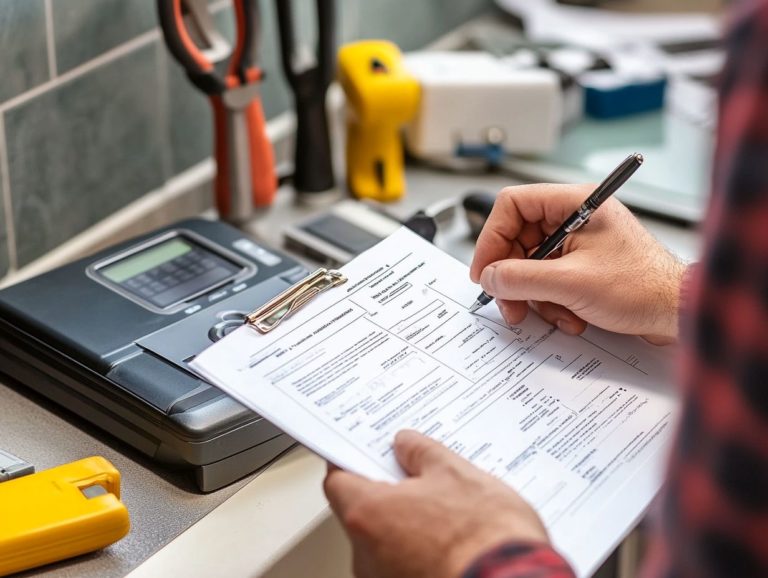The Process of Claiming Repair Costs
Repair costs can feel overwhelming, whether you re facing a damaged vehicle, home, or appliance.
Grasping the intricacies of repair costs and claims is vital for navigating this often-daunting process. This article will break down the various types of repair costs, guide you through filing a claim, and provide you with strategies for negotiating with insurance companies. This article will also explore alternative options for managing unexpected costs. Armed with this knowledge, you ll be well-equipped to tackle any repair challenges that come your way.
Contents
- Key Takeaways:
- Understanding Repair Costs and Claims
- Types of Repair Costs
- How to File a Repair Cost Claim
- Negotiating with Insurance Companies
- Alternative Options for Covering Repair Costs
- Frequently Asked Questions
- What is the process of claiming repair costs?
- Who is responsible for paying for repair costs?
- What information do I need to provide when claiming repair costs?
- What is the timeline for claiming repair costs?
- Will my insurance premium increase if I claim repair costs?
- Are there any alternatives to claiming repair costs?
Key Takeaways:

- Understand what repair costs and claims are, and how they can help you cover unexpected expenses.
- Before filing a claim, gather all necessary documents and information to ensure a smooth process.
- When negotiating with insurance companies, be prepared and knowledgeable to increase your chances of a successful outcome.
Understanding Repair Costs and Claims
Understanding repair costs and claims is essential for homeowners in the United States, particularly when it comes to filing insurance claims for home repairs. Whether you re a single homeowner or part of a couple, grasping the nuances of repair-related expenses equips you to navigate the intricate landscape of homeowners insurance and IRS guidelines.
Remember, some repair costs could include tax-deductible expenses, like capital improvements major repairs that add value to your property which can influence your home s cost basis (the original value of your property for tax purposes) when it s time to sell.
What are Repair Costs and Claims?
Repair costs refer to the expenses you incur to maintain or restore your home, while claims are requests you make to insurance companies for reimbursement related to those costs. Understanding this distinction is crucial for you as a homeowner.
Repair costs can encompass routine maintenance tasks, such as fixing a leaking roof or replacing a broken window, which you pay for directly out of pocket. Conversely, a claim may be filed for significant damage caused by a storm or fire, allowing you to seek insurance compensation to cover those unexpected expenses.
Homeowners insurance plays a vital role in alleviating your financial burden during such events, as it can help offset repair costs through approved claims. It’s also important to note that in certain situations, the IRS may permit you to deduct specific expenses related to repairs or claims, depending on the nature of the damage and whether it meets certain tax criteria.
Types of Repair Costs
Regarding home repairs, grasping the different types of repair costs is vital for homeowners. This knowledge gives you the power to effectively manage fixing-up expenses and capital improvements, both of which can significantly impact your property s value and potential tax deductions.
Common Types of Repair Costs

Common repair costs that you, as a homeowner, will likely encounter include essential household repairs like plumbing, roofing, and electrical work. These repairs are vital for maintaining the integrity and safety of your home.
You might also encounter expenses like replacing appliances and maintaining your HVAC system. The urgency and impact of these costs can vary widely. For example, a leaky roof requires immediate action to prevent costly damage, while fixing a cracked tile might be a low-priority task that can wait.
Unexpected events like storms or accidents often lead to property damage that requires swift action to mitigate costs and ensure safety. To navigate these expenses effectively, consider establishing an emergency fund, obtaining comprehensive insurance, and prioritizing repairs based on necessity. This approach will help you keep your home in excellent condition while minimizing financial strain.
How to File a Repair Cost Claim
Filing a repair cost claim is a methodical process that you need to navigate carefully to secure the appropriate reimbursement from your homeowners insurance for essential repair expenses you’ve incurred. Following the right steps will ensure you maximize your benefits and streamline your experience.
Steps to Take Before Filing
Before filing a repair cost claim, take essential steps to gather all necessary documents. This will support your claim for tax relief and reimbursement.
Start with a thorough assessment of the damage. Identify the extent of the repairs required. Detailed photographs and notes will help illustrate the situation to insurers or tax authorities.
Next, gather multiple quotes from reputable contractors. This provides a range of repair costs and shows your careful choice of a service provider.
Maintain meticulous records of any repairs undertaken. This will simplify verification during the claims process.
By following these preparatory steps, you can streamline your claims and enhance your chances of receiving the assistance you need.
Essential Documents for Your Claim
To successfully file a repair cost claim, gather specific documents and information, such as receipts, estimates, and detailed descriptions of the property damage and required repairs.
Compiling these essential documents ensures a smoother process and minimizes disputes. Receipts provide proof of costs incurred, while detailed estimates from professionals validate necessary repairs.
Don’t underestimate the power of visual evidence. Photographs of the damage can significantly strengthen your claim.
To streamline your submission process, organize these documents both chronologically and categorically. This allows for easy access and review.
Consider using a dedicated folder, either physical or digital, to maintain order. This ensures that all your documentation is readily available for discussions with your insurance provider.
Negotiating with Insurance Companies

Negotiating with insurance companies may feel like an uphill battle. However, understanding the process can help you secure the reimbursement you deserve for your repair costs.
Tips for Successful Negotiation
Successful negotiation with insurance companies requires preparation, assertiveness, and familiarity with your policy details and repair costs.
As you navigate the complex landscape of insurance claims, approach discussions with a mindset emphasizing collaboration over confrontation. Empathy can lead to more productive conversations.
Clearly outline your needs and priorities from the outset. This ensures alignment with the insurer.
Having all necessary documentation such as estimates, photographs of damages, and previous communications organized and readily available strengthens your position.
This level of preparation instills confidence and signals to the insurer that you are serious about reaching a fair resolution.
Alternative Options for Covering Repair Costs
Exploring alternative options for covering repair costs can offer invaluable financial support to homeowners. Act quickly, especially when insurance claims don t fully cover your repairs or when faced with substantial property damage.
Gather your documents promptly to ensure you are ready for negotiations.
Other Sources of Financial Assistance
As a homeowner, you may discover a wealth of additional financial assistance options, including government programs, non-profit organizations, and community resources designed to help families manage repair-related expenses.
These programs can vary widely in who can apply. They often consider factors like income level, geographical location, and your household’s specific needs. For example, certain federal initiatives might offer grants for low-income homeowners to tackle critical repairs. Local non-profits could provide interest-free loans for enhancements.
Understanding the application process is crucial. Some programs require a lot of paperwork, while others have simplified online forms. By exploring these diverse options, you can uncover valuable support tailored to your unique situation, helping you maintain a safe and secure living environment.
Frequently Asked Questions

What is the process of claiming repair costs?
The process of claiming repair costs involves filing a claim with your insurance company for any damages or repairs needed for your insured property or vehicle.
Who is responsible for paying for repair costs?
The responsibility for paying for repair costs depends on the type of insurance coverage you have. If you have full coverage, your insurance company typically covers the costs. If you have liability-only coverage, you may be responsible for paying for the repairs yourself.
What information do I need to provide when claiming repair costs?
When filing a claim for repair costs, you must provide proof of the damage, such as photos or video footage. You will also need to provide estimates for the cost of repairs and any other relevant documentation requested by your insurance company.
What is the timeline for claiming repair costs?
The timeline for claiming repair costs can vary depending on your insurance company and the severity of the damage. File your claim now to avoid delays and get the help you need! Your insurance company will typically provide you with a timeline for the claims process.
Filing a claim for repair costs may result in an increase in your insurance premium. This is because insurance companies view individuals who make claims as a higher risk. It is essential to weigh the cost of repairs against the potential increase in premiums before filing a claim.
Are there any alternatives to claiming repair costs?
If the cost of repairs is relatively low, it may be more cost-effective to pay for the repairs out of pocket instead of filing a claim. This can help prevent an increase in your insurance premium and save you money in the long run.
Explore your options today!





